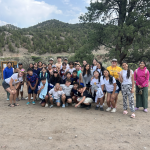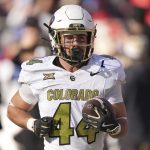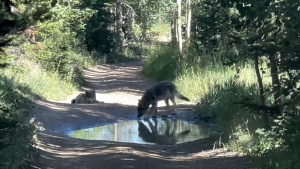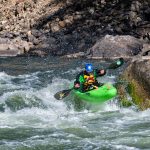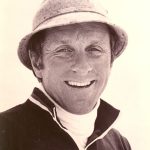Upper Colorado River will not be ‘Wild and Scenic,’ but conservationists still satisfied with new plan

Special to the Daily
EAGLE COUNTY — The Catamount gauge on the Colorado River is a result of a big collaboration, and for now, it has gone a long way in quelling the concern of conservationists in the Upper Colorado River Wild and Scenic Stakeholder Group.
Couple that with a few good-faith efforts from Front Range diverters to get more water into the river, and most everyone seems to be convinced that collaboration has been a lot better than the courtroom in this case.
The stakeholder group was formed in 2008, and its mission was overt — convince the Bureau of Land Management and the U.S. Forest Service not to write a report stating that the Upper Colorado River is suitable for a Wild and Scenic Designation from the federal government.
The National Wild and Scenic Rivers System was created to preserve certain rivers with outstanding natural, cultural, and recreational values in a free-flowing condition for the enjoyment of present and future generations. The legislation that created the system was of more than 300 conservation measures signed into law by President Lyndon B. Johnson from 1965 to 1968, which formed what the National Park Service calls “the legal basis of the modern environmental movement.”
But while it takes an act of Congress to welcome a new river into the Wild and Scenic Rivers System, a report from the Bureau of Land Management or U.S. Forest Service saying a river is suitable for wild and scenic designation can trigger a change in management for the river.

Support Local Journalism
“The suitability study is the most important step,” said Upper Colorado River Wild and Scenic Stakeholder Group spokesperson Rob Buirgy. “Because if the agency designates that portion of river as potentially suitable for wild and scenic designation … They manage it under a new set of protective measures.”
Objections no surprise
For big-city water rights holders on the Front Range, dependent on water from the other side of the Continental Divide, the words “free-flowing condition” and “new set of protective measures” are a bit nerve-racking when it comes to the Upper Colorado River.
“Once you’ve given federal wild and scenic designation to a piece of water, it makes it very difficult for water providers to create any new water projects,” said Jack Bombardier, who lives on the Colorado River in Eagle County and participated in the collaborative. “That’s why Denver Water, Colorado Springs Water, Northern Water, Aurora Water, all really objected, 10 years ago, when the idea was floated to make the Colorado wild and scenic.”
Water rights holders’ objections to wild and scenic designation for the Upper Colorado River did not come as a surprise to many, Bombardier said.
“Personally, if I could get wild and scenic status, I’d be delighted with that,” Bombardier said. “But it’s probably not going to happen. Denver Water would fight that to the last, along with every other water provider, to protect water that they legally own.”
To Bombardier, an angler and guide whose livelihood depends on the Colorado River having a healthy fishery, the choice was obvious.
“Denver water … is not obligated to release anything,” Bombardier said. They could say … ‘we’ll see you in court.’ OK, maybe if you took it to court, then appeals court, maybe five years from now you win a victory and they say ‘OK, now we’re going to give you more water.’ Meanwhile, over those five years, you’ve got fish dying.”
‘We’d have beers’
Ken Neubecker has been following local water issues in Eagle County for decades as an original organizer of the Eagle River Watershed Council and the Colorado Project Director for American Rivers.
Neubecker said when the wild and scenic talks first began, trust did not flow back and forth on either side of the divide like water.
“There was still some speculations, even up until a couple of years ago, that Front Range folks were trying to subvert the process, or do something to derail it,” he said.
But the group got to know each other pretty well over the years.
“We’d have meetings, we’d have beers afterward, we’d have annual outings where you sit around a campfire, and you get to know people on a personal level, they’re not just a letterhead name,” Bombardier said.
The group decided conditions would need to be monitored, and metrics would need to be assigned to determine if the river was in good standing with the conservationist subset of the stakeholder group.
Buirgy said the Colorado Water Conservation Board supported the stakeholder group using the state’s Wild and Scenic Rivers Fund for scientific studies, recreational surveys, and stakeholder group coordination and facilitation. The stakeholder group also recommended that the board appropriate three in-stream flow water rights to preserve the natural environment on the river from the confluence with the Blue River to the area just above the confluence with the Eagle River. The Colorado Water Conservation Board appropriated and the water court decreed those water rights in 2013.
Colorado Parks and Wildlife is expected to help install biological metric tracking tools along the river in the coming months, and a few years ago a new USGS temperature and flow monitoring gauge was installed at the Catamount Boat Launch, near Bombardier’s house, which will measure temperature and serve as a resource guide.
While resource guides do not mandate management action based on their readings, good-faith management efforts have been undertaken based on the Catamount gauge’s readings during the collaborative process. Bombardier says the readings have been crucial for that stretch of the river, which is prone to warm temperatures.
“Just trying to monitor flows there was always difficult, because the nearest gauge upstream was up at Kremmling, but there’s a lot of surface water that enters the river between there and Dotsero,” Bombardier said.
Bombardier used to measure temperatures using his own thermometer, but it wasn’t as scientific and credible as an official USGS gauge.
In 2012, during a period of low water, he sounded the alarm that temperatures were getting too hot for fish, and that’s when he got to know some of the members of the collaborative known as the Upper Colorado River Wild and Scenic Stakeholder Group.
The email list
The collaborative is made up of 26 entities made up of six different interest groups — East Slope water users; Western Slope water users and land owners; float boating; conservation, environment and fishing; state governments; local governments.
Bombardier joined the collaborative as a member of the conservation, environment and fishing interest group.
In 2018, like in 2012, temperatures on the Colorado River near Catamount approached a level where fish could start dying if flows didn’t improve. In 2018, however, unlike 2012, Bombardier was card-carrying member of the collaborative, referencing a USGS gauge in an email list of water diverters who knew him personally. He received quite a response.
Bombardier recounted the story to the Vail Daily:
“I sent out an email to the whole group, 150 people on that list,” he said. “I said ‘Hey folks, the river is getting warm, I know we’re trying to get some reservoirs filled up, but we could really use some water down here right now … that was at 7 p.m.. At 8 p.m. I got an email from (Peter Fleming, General Counsel for the Colorado River Water Conservation District,) saying ‘Jack, I saw your email, just so you know, we’re going start releasing 70cfs tomorrow from Wolford Mountain, hope it helps.’ I thought that’s pretty good, I sent out an email an hour ago and now we’re going to get 70cfs, that’s not going to fix the problem, but it helps.
“Next morning I get an email from (Kathleen Melander, Senior Water Resources Engineer at Northern Water), ‘Jack, got your email, we’re going to stop the Windy Gap pump early and send you guys an extra 150 cfs from Lake Granby.’ I thought awesome, now we’re up to 200 cfs, that’s substantial.
“Then I get another email from (Kevin Urie, Environmental Planner, Denver Water), ‘Jack, saw your email, we’re going to send you an extra 150 from Williams Fork until the weekend, then we’re going to bump it up to 300 after Monday.”
‘Best shot we’ve got’
Neubecker said after spending more than a decade working toward Wild and Scenic designation on the Upper Colorado River, he feels the collaborative group’s plan represents the best effort conservationists could have expended toward maintaining the Upper Colorado River’s “outstandingly remarkable values,” or ORVs.
“It got all of the people who would have been opposed to actual designation to sit down at the table and work out a plan that — if everybody plays along — will have the best shot we’ve got at protecting those ORVs,” Neubecker said.
The agreement was formerly accepted by the Bureau of Land Management and U.S. Forest Service in July. Participating groups include: American Rivers, American Whitewater, Aurora Water, Blue Valley Ranch, Colorado River Outfitters Association, Colorado River Water Conservation District, Colorado Springs Utilities, Colorado Whitewater, Confluence Casting, Conservation Colorado, Denver Water, Eagle County, Eagle Park Reservoir Company, Eagle River Watershed Council, Eagle River Water and Sanitation District, Grand County, Middle Park Water Conservancy District, Municipal Subdistrict of the Northern Colorado Water Conservancy District, Northern Colorado Water Conservancy District, Northwest Colorado Council of Governments, Summit County, Upper Colorado Commercial Boaters Association, Upper Colorado River Private Boaters Association, Upper Eagle Regional Water Authority, Vail Associates, Inc., and Yust Ranch.



